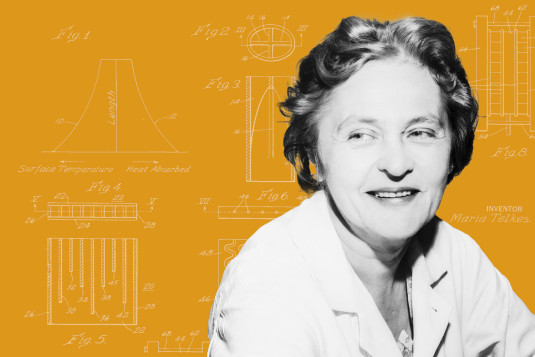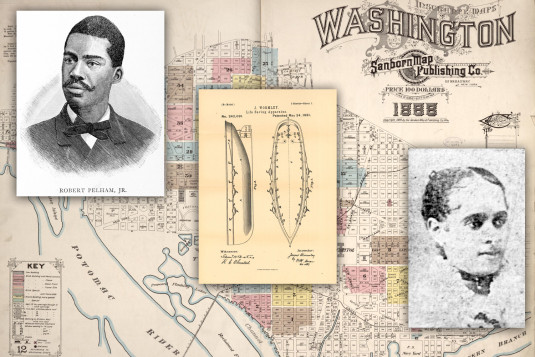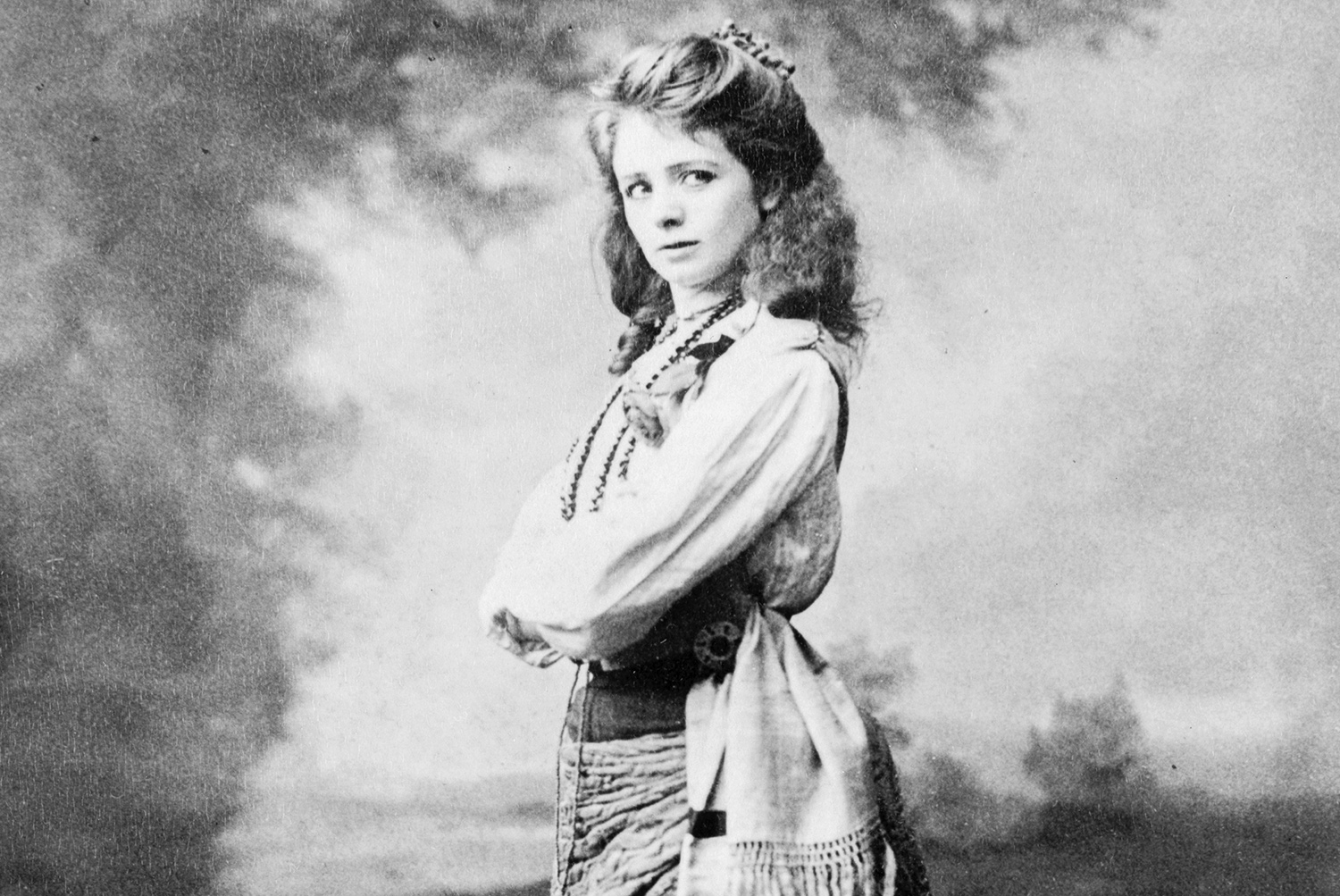
Out of the limelight
Maude Adams, the most famous actress of the early 20th century, worked with engineers at General Electric to invent and patent the largest incandescent bulb to date. This and her other innovations in lighting and stagecraft revolutionized the performing arts and delighted audiences across the country.
16 min read
Each month, our Journeys of Innovation series tells the stories of inventors or entrepreneurs who have made a positive difference in the world. This month’s story focuses on the journey of the actress, production designer, and inventor Maude Adams.
“Maude Adams was the greatest production artist this country ever saw,” according to Bassett Jones, a pioneer of early-20th-century lighting design. Adams was also the most famous American actress of the 1900s and 1910s, originating the role of Peter Pan in the United States and working behind the scenes on the era’s most sumptuous stage productions. With no formal training in electrical engineering but a wealth of experience in stagecraft and performance, she helped transform American theater, both as an actress and a designer. Moreover, she contributed to what became the largest light bulb patented to date. Adams, a giant in the art and science of theater, nonetheless kept fans in the dark as to her personal life and private passions.
Adams was born on November 11, 1872, in Salt Lake City, Utah. Almost immediately, she began touring the Western states with her mother, Annie, an actress, and made her own acting debut at only 9 months old. On the road, Annie taught Maude to read, write, act, and memorize lines and then supplemented this elementary education with a few years of schooling back in Utah.
By the time she was a teenager, Maude Adams had a solid career on the stage. She made her New York debut in 1888. Then as now, New York City provided the largest market for performers and producers alike. One such producer, Charles Frohman, emerged as the industry leader in the 1890s, shortly after taking on Adams as one of his regular players. In the early 1900s, he helped make Adams the most famous and highest-paid actress in the country.
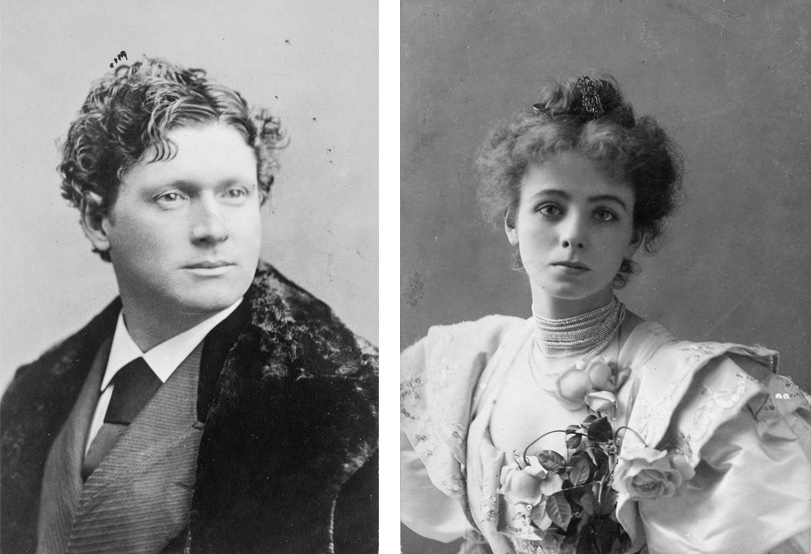
Charles Frohman (left) and Maude Adams (right) photographed around the time they teamed up, in 1889. She eventually became his highest-grossing performer. Frohman also relied on Adams’s intuition and expertise in the areas of stagecraft and lighting. She designed the light bridge at the Empire Theater in New York City, Frohman’s main venue. Collections of the National Portrait Gallery, Smithsonian Institution (left), and the New York Public Library, Billy Rose Theatre Division (right).
The great leap to stardom sprang from Adams and Frohman’s first collaboration with the British author James M. Barrie, a new comedy titled “The Little Minister.” Test runs in several U.S. cities generated the requisite buzz for Adams’s appearance as Lady Babbie, the play’s heroine, in New York City. She was also responsible for the lighting, having realigned the theater’s arc lamps to achieve a soft, dreamy mood for the scenes set in the woods.
At Adams’s first entrance on opening night, September 27, 1897, audience members leapt to their feet. The applause and cheering lasted for two minutes. The ensuing performance exceeded expectations. Standing ovations recalled Adams to downstage center, where she took bow after bow, a total of 10 times after the second act and 12 times after the final curtain. “She is now firmly entrenched in her new stellar position,” an influential critic observed a few weeks into the show’s run, “and is likely to become a popular idol.”
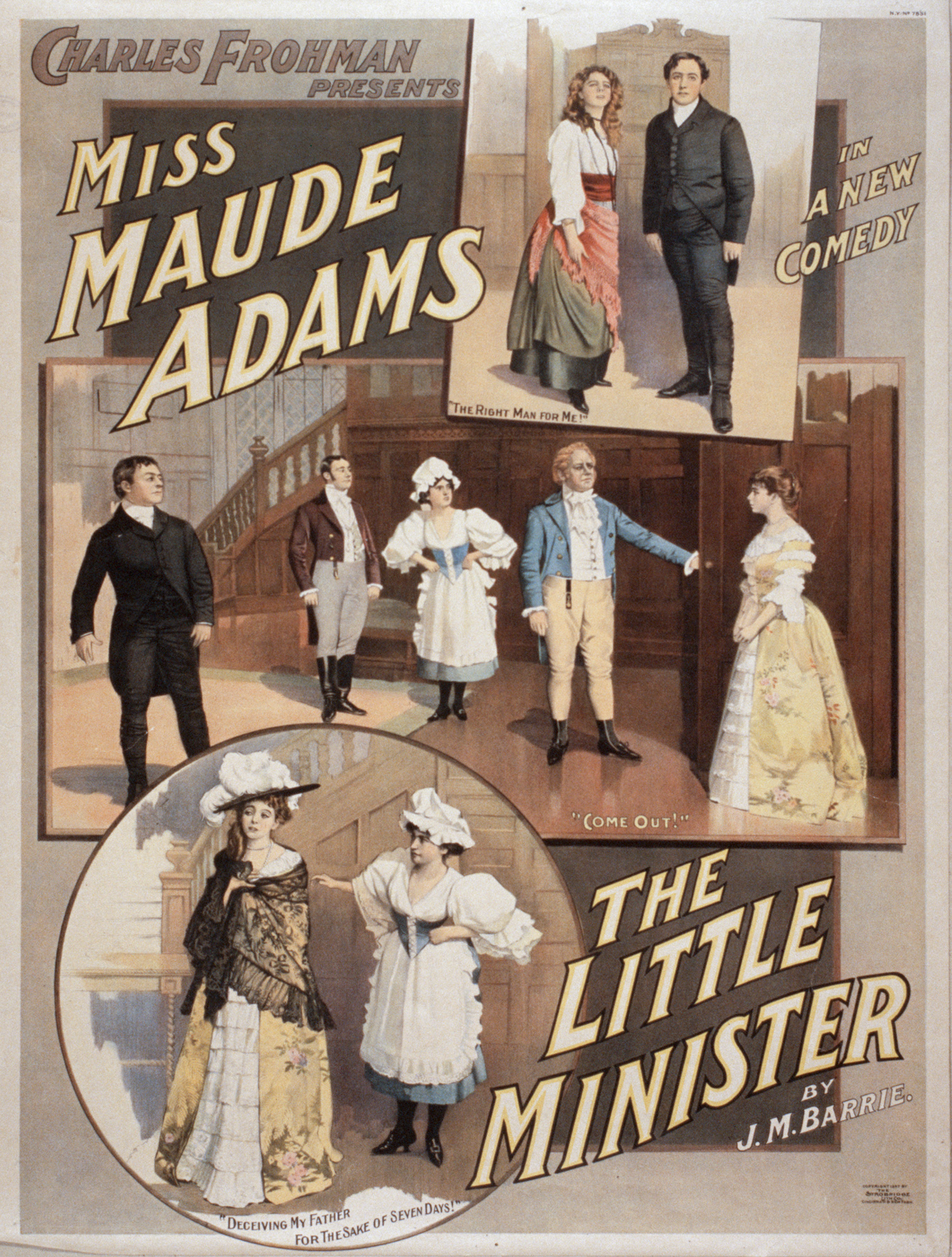
Maude Adams starred as Lady Babbie in Charles Frohman’s production of “The Little Minister” in the fall of 1897. Collection of the Library of Congress.
Adams became much more than an idol. She proved herself to be a production designer and manager in her own right. For her next play, William Shakespeare’s “Romeo and Juliet,” Frohman granted Adams authority over most of the technical elements. He continued to trust her with the production values for the next several projects, a rare arrangement in early-20th-century show business. For “L’Aiglon” (1900), Adams oversaw the scenic, costume, and lighting design, all while crafting an authentic performance as the Duke of Reichstadt. She even traveled to Vienna to research the setting and capture the atmosphere.
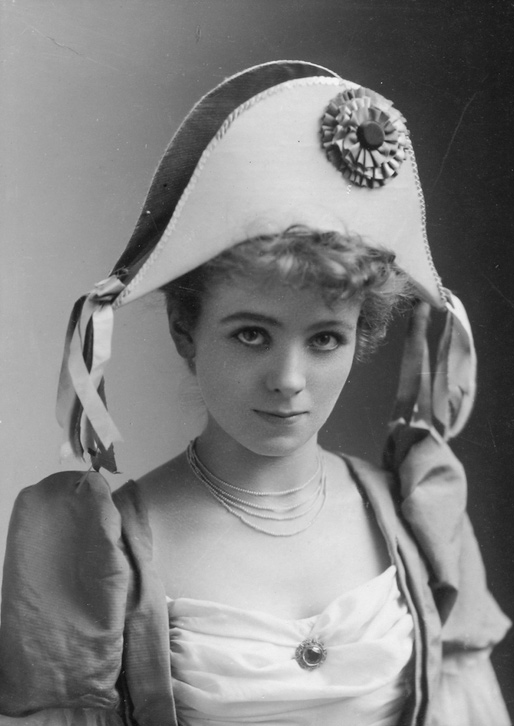
Maude Adams in a promotional photograph for “L’Aiglon” (1900). In the production itself, she wore an Austrian military officer’s uniform. Courtesy of the New York Public Library, Billy Rose Theatre Division.
Meanwhile, Frohman and Adams planned the U.S. production of Barrie’s “Peter Pan,” with Adams cast as the title character. Adams’s performance, as well as her work with costume, lighting, and scenic designers on the realization of the Darlings’ London home and the dreamworld of Neverland, resulted in a smash hit that played more than a thousand times.
Adams gained even greater artistic independence off the Broadway stage, at Harvard, Yale, and the University of California. There, she mounted productions of epic proportions, to the delight of students, faculty, and local theatergoers. In 1908, for a performance of “Twelfth Night” in which she played Viola, Adams transformed Harvard’s largest auditorium into a Shakespearean theater, complete with a painted canvas sky, ornamental pillars, and gallery seating. Modern touches included a concealed orchestra and mood lighting, which dazzled students and professors, who agreed to attend the performance in period costume. Frohman fronted the $10,000 cost, and the proceeds went to the English Department. A scaled-down version played at Yale.
On the heels of this success, Adams crafted and executed the largest theatrical spectacle to date, at Harvard’s football stadium, in 1909. There, with the help of more than a thousand cast and crew members, she recreated the life and death of Joan of Arc according to the classic work of Romantic drama “The Maid of Orleans” by Friedrich Schiller. (Proceeds for this production would go to Harvard’s German Department.) With scaffolding and mock landscaping, Adams had half the stadium remade into a battlefield of the Hundred Years’ War. A team of stage managers, scenic builders, and costume designers executed her vision, and as the date of the performance approached, Adams took regular Sunday trips by train from New York to Cambridge, where she ensured these technical and artistic efforts would translate to success.
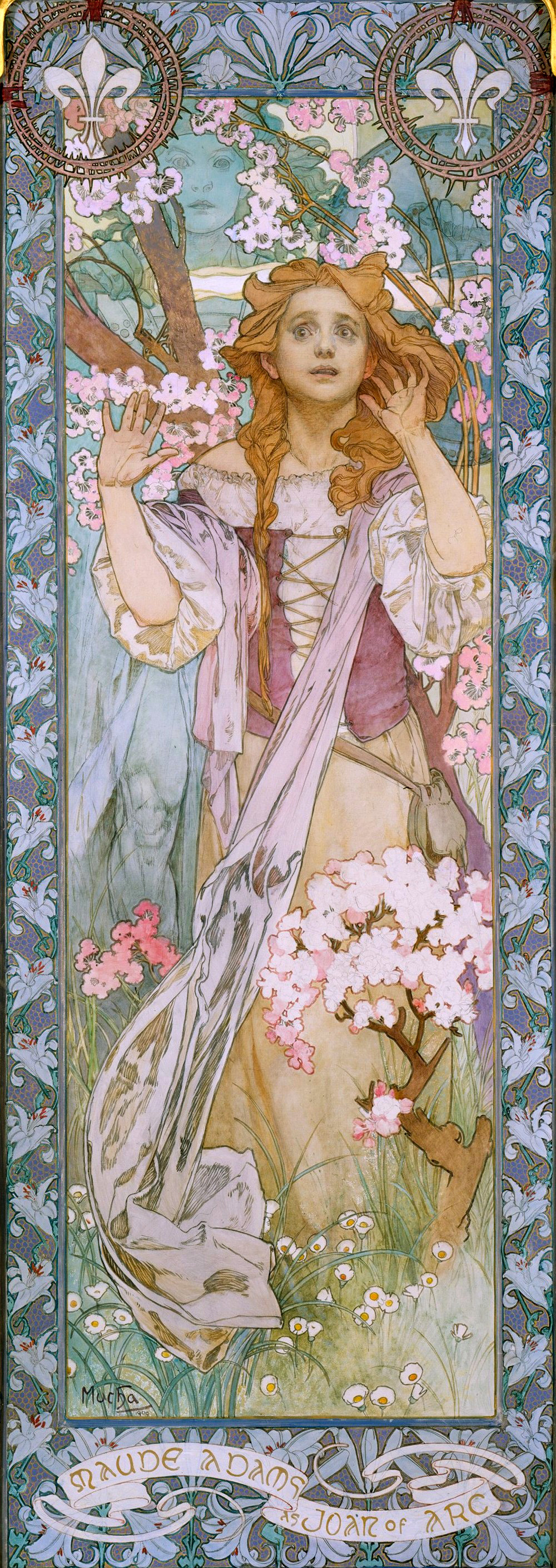
Alphonse Mucha created this promotional poster for Maude Adams’s adaptation of Friedrich Schiller’s “The Maid of Orleans,” performed at Harvard University Stadium in June 1909. Courtesy of the Metropolitan Museum of Art, Gift of A. J. Kobler, 1920 (20.33).
“The Maid of Orleans” production showcased Adams’s innovations in lighting design in particular. Lighting cues helped focus the audience’s attention on specific scenes as they played out, a strategy familiar to us today but new in the early 20th century. A system of colored lights, visible only to the players, helped them keep track of when to move and when to speak, since the scale of the stage made following cues particularly difficult. With Adams onstage (and on horseback) and carrying the play as its title character, 11 stage managers had to make sure the transitions from scene to scene unfolded seamlessly. That wasn’t easy, given the 1,150 extras milling about, some on horses, some on foot, and in mock armor imported from Europe. Behind the scenes, 50 assistants managed mid-show costume changes for this army of performers, while 200 stagehands maneuvered massive pieces of scenery as if by magic. Some 15,000 people attended the show—so many, in fact, that the state militia and police had to do crowd control, and public transit authorities increased service to cope with the demand. Adams, already the most famous actress in the United States, now became the country’s most ambitious and impressive theater impresario.
Following her triumph in Massachusetts, Frohman announced that Adams would “personally produce” Shakespeare’s “As You Like It” in 1910, “on the order of her previous outdoor pageants,” this time at the University of California, Berkeley.
Several thousand people showed up to see Adams’s latest outdoor spectacular as the sun set over California. Critics singled out the lighting in particular for special praise. Actors seemed to glow as they moved, whereas scene transitions happened in pitch black (another convention familiar to modern theatergoers but new in the 1910s). Critics were elated. “What the audience saw,” according to one review, “was a consecutive series of graceful Quattrocento pictures, glowing in color, wonderfully framed by the purple night and moving upon a canvas,” “an exquisite illusion,” a “beautiful panorama.” At the close of the last act, the audience sat in silence, stunned by the experience, before bursting into wild applause and ovations.
Adams’s audiences were experiencing a revolution in lighting design underway since the early 19th century but accelerated by Adams and her team. Electricity was replacing older modes of illumination, such as kerosene lamps, natural gas jets, and limelight spots. In 1879, the Edison Corporation had invented an electric lamp bright enough for theatrical use and advertised the breakthrough at Munich’s 1882 Electrical Exposition. Soon, theaters all over the world were switching to electric bulbs, yet the technology still had several disadvantages. The filaments were sensitive and needed absolute stability, so moving a light to refocus its beam was usually out of the question. The lamps ran very hot, too, and generated a glare that washed out scenery, costumes, and faces.
Since the 1890s, Adams had been experimenting with new methods of lighting and modes of scenic design. She worked with technicians and engineers to do away with gas lighting altogether, perhaps the first such effort in the history of American theater. To mitigate glare, she used special fabrics for sets and costumes that eliminated shadows and diffused rather than reflected light. These breakthroughs became crucial to the success of “Peter Pan,” which called for actors to fly through the night, with the help of cords and winches, against a backdrop of stars and planets.
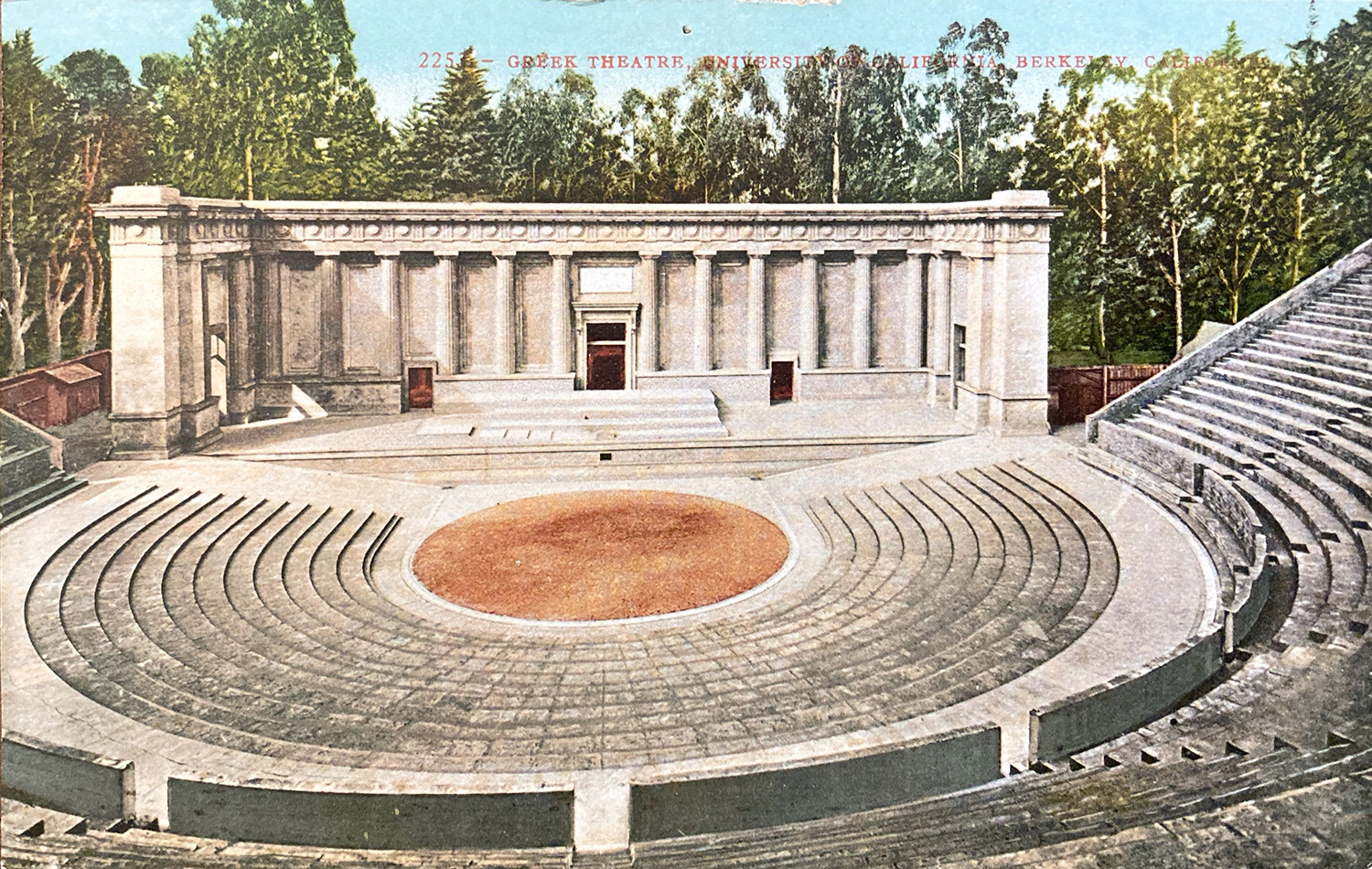
Maude Adams’s production of William Shakespeare’s “As You Like It” took place in June 1910 at the Greek Theatre on the campus of the University of California, Berkeley, pictured here on a postcard from 1911.
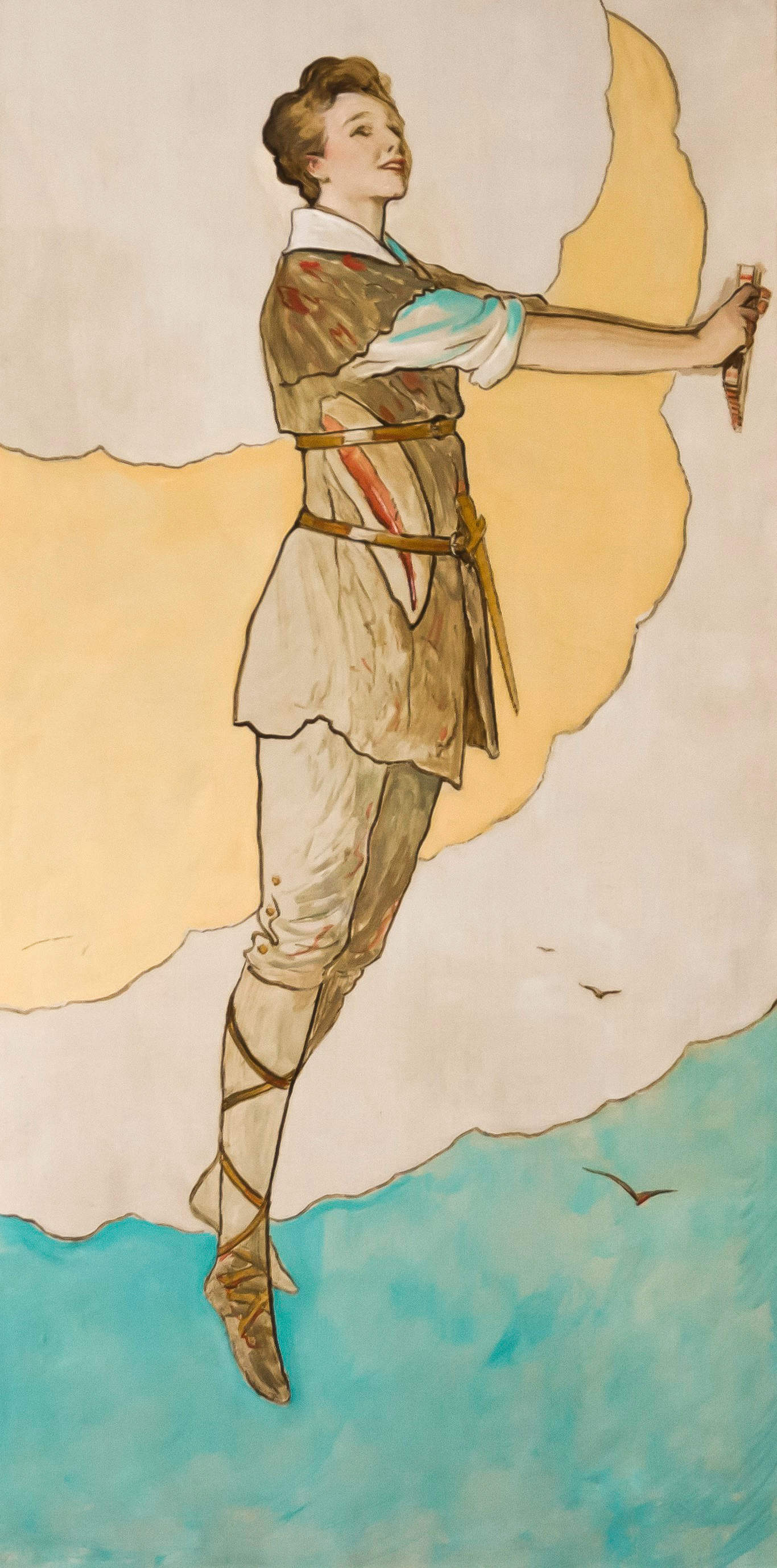
The artist, costumer, and scenic designer John W. Alexander painted a series of portraits of Maude Adams as Peter Pan around 1905-06. Adams and Alexander were close friends and worked together to refine the interplay of light and textiles onstage. Courtesy of the State of Utah Alice Merrill Horne Art Collection.
By the 1910s, Adams had jettisoned footlights and border lights, the standard arrangement for electric bulbs, and suspended lamps from catwalks high above the stage itself to achieve tightly focused pools of illumination around the actors and scenery below.
Adams’s personal genius for acting and stagecraft were apparent by this point, but she never worked alone. Several people and forces combined to enable Adams to realize her visions in a period when the theater industry marginalized women, especially women involved in technical stagecraft. Adams became a brilliant exception in part because she had the support of Frohman, her domestic partners, and a community of people who, at the time, might not have referred to themselves as gay or lesbian, but who were nonetheless committed to same-sex relationships of love and devotion.
Frohman and Adams were both in long-term same-sex relationships. Adams had two, in fact, her first only ending with her partner’s early death in 1901. The loss sent Adams into a temporary retirement, which entailed extended stays at a spa-sanatorium and convent in Europe, out of the public eye.
From 1905, and for almost the rest of her life, Adams lived with the second of her two life partners, Louise Boynton, who had her own career as an editor, author, and publisher, and they are buried together at Adams’s former estate in New York. Frohman, Adams, and Boynton carefully concealed their private lives from an adoring but potentially unaccepting public. Frohman took pains to keep stories of Adams’s domestic relationships out of the press, and he allowed rumors to circulate that posited romantic connections between Adams and men—himself, even. None of these rumors were true, but they provided good cover.
Frohman and Adams’s preferred strategy to protect Adams’s reputation was to present her as unimpeachably chaste. When she gravitated toward convents as convenient escapes from the rigors of fame and career, Frohman was quick to play up the association between Adams and the nuns: they all renounced sexuality for a higher purpose. Nevertheless, Adams’s sexuality was a fact of her life—a fact that makes her accomplishments all the more impressive. She managed to work, innovate, and excel under public scrutiny, against a backdrop of misogyny and homophobia that might have brought her down in scandal at any moment.
Yet neither Adams nor Frohman was quite “in the closet,” either, as we’d put it today. They created productions that appealed to gay and lesbian audiences on purpose, with elements that extended a winking glance and wry smile to people steeped in the coded references to the cultural lives of LGBTQ Americans at the turn of the 20th century.
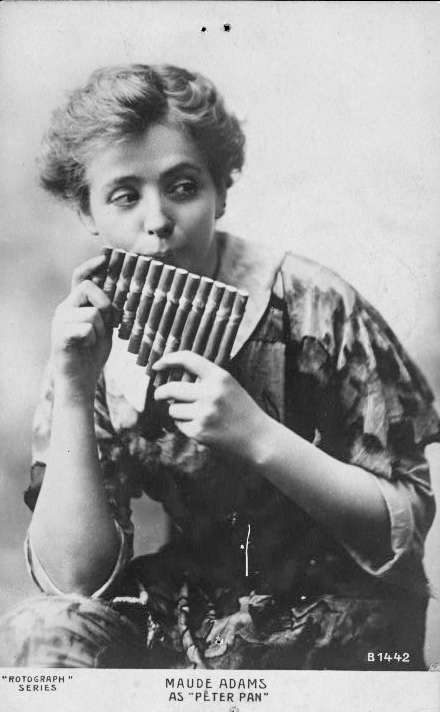
Maude Adams first played Peter Pan in 1905, and by the end of her career had appeared in the role some 1,500 times. Courtesy of the New York Public Library, Billy Rose Theatre Division.
Audiences could and did read Adams’s choice to play male or male-presenting characters—Peter Pan, the Duke of Reichstadt, Joan of Arc, a court jester, and a rooster, even—as a challenge to the strict rules on gender and sexuality then current in the real world. Suggestive motifs, phrases, and costuming choices, moreover, spoke directly to audience members outside the sexual mainstream.
“The only thing that can save [Tinkerbell] is for you to believe in fairies. Do you believe in fairies?” was a line in “Peter Pan” delivered directly to the audience by an actress in drag, playing a character who lived in a dreamworld according to his own sense of right and wrong, supported by a group of lost boys (also actresses in drag). As such, the line had multiple meanings, to be sure, but one of them, according to theater historians, was a plea for compassion and understanding when it came to members of a sexual minority. Lesbians in the audience rewarded Adams by making her one of their idols. A fan base developed that itself constituted a kind of community organized around admiration for Adams as a prominent and beautiful example of successful “queer” womanhood.
In this way, Frohman and Adams presented material to the American public that, in a certain light, provided support, representation, and visibility to LGBTQ audience members. This effort, like Adams’s endeavors in stagecraft, rested on a deep and special understanding between her and Frohman—one that lasted until Frohman’s death in May 1915 aboard the Lusitania after it had been torpedoed by a German U-boat. Adams was devastated by the news but managed to organize a memorial service for hundreds of mourners.
In the next several years, Adams devoted her full attention to the problems of stage lighting. Around 1920, she realized that her experience, expertise, and intuition might be useful to the nascent film industry. She began work the following year with the General Electric Corporation (GE) in upstate New York on a bigger, brighter incandescent bulb for stage and screen.
GE’s director, Willis R. Whitney, recognized Adams’s scientific aptitude immediately. “Where did she get it?” he asked. The answer should have been clear enough. Never having attended college or high school, she got it from years of innovation on stages across the United States, from Broadway to Berkeley.
Adams and Boynton, by now longtime domestic partners, rented a house near GE’s labs, where Adams charted the progress of a team of engineers, participated in brainstorming sessions and experiments, and offered insights on applications of the new technology. The idea was to use tungsten filaments to allow for high wattage and easy maneuverability of the fixture.
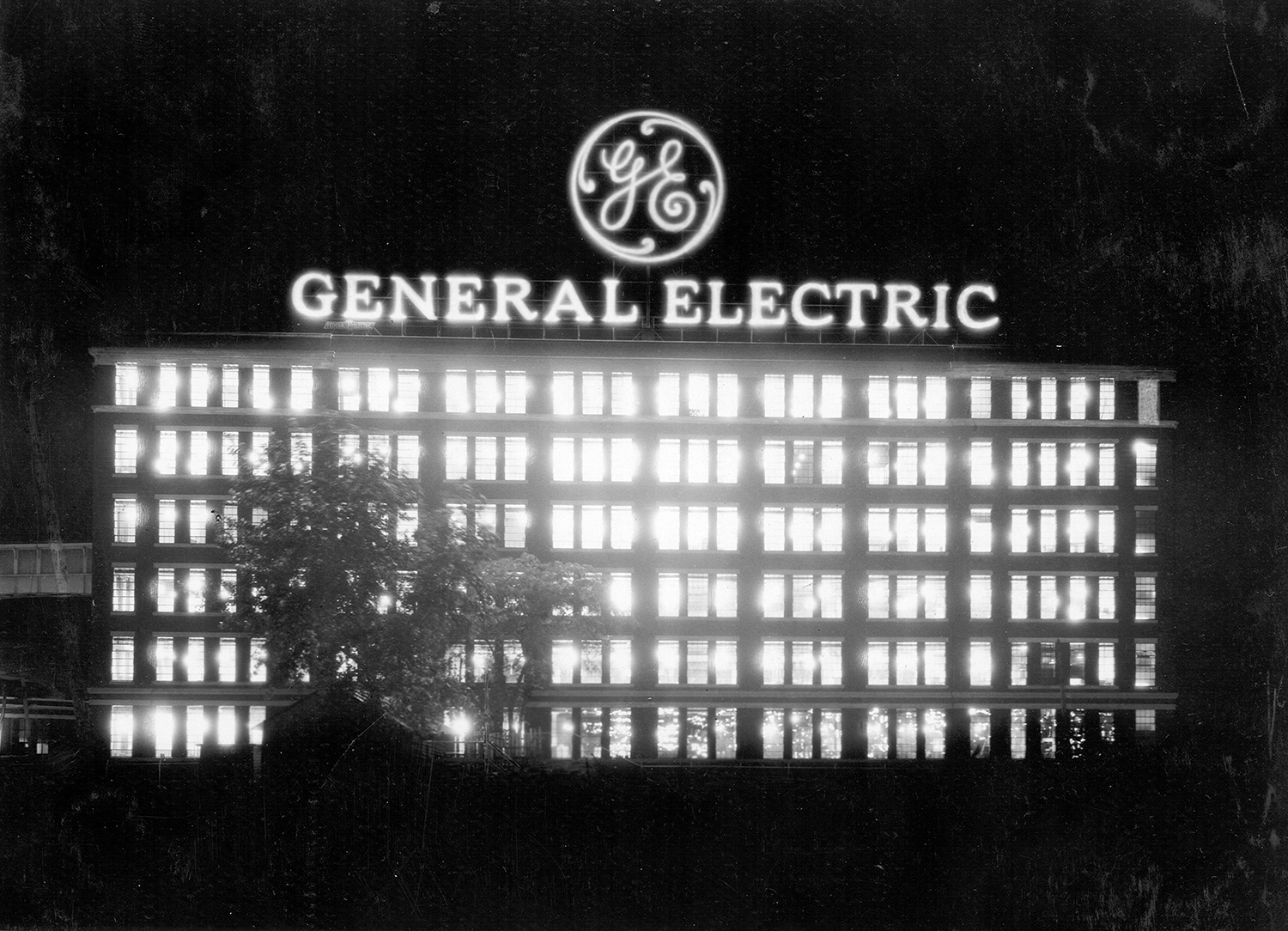
Maude Adams moved to Schenectady, New York, in the early 1920s to work with scientists and engineers at the GE Research Laboratory. In 1925, GE opened a new laboratory headquarters that also functioned, at night, as an advertisement for the corporation’s prowess in developing better, brighter electric light bulbs. Courtesy of miSci, Museum of Innovation and Science.
Several months into the project, Adams invited Whitney to witness the progress. What he saw—a prototype of the massive incandescent bulb—shocked and delighted him. Still, the invention wasn’t quite operable, and another two years passed before Adams and the engineers had a working product that was ready for market. The last stage of development, perhaps the most important, was where Adams’s expertise became most valuable. She ensured that further adjustments to the bulb, especially with respect to its maneuvering and focusing capacities, would make it appealing to theater and movie producers.
At the same time, Adams was experimenting with early color film technology, especially as it related to lighting. News of these latest forays attracted the interest of George Eastman, whose company led the industry in the manufacture of film for motion pictures. An agreement between Eastman, GE, and Adams came to naught, however, as Adams preferred to return to the entertainment industries, where all her creative faculties might be employed—not just her expertise in lighting design.
After this parting of ways in 1923, GE continued work on the bulb, patenting it, finally, in the early 1930s. By that time, the bulbs were already in use all over the country. GE credited Adams as the first inventor on three patents: U.S. Patent No. 1,884,957, for an “illuminating device” (the massive lamp itself); U.S. Patent No. 1,963,949, for a “high powered illuminating device” (a cooling apparatus and supporting frame for the lamp); and U.S. Patent No. 2,006,820, for another “illuminating device” (the system for supporting the filament, thereby allowing the lamp to be moved without incident). Taken together, the patents presented a marketable lighting system that featured the world’s largest incandescent bulb. Using 30,000 watts, it could do the work of some 60,000 candles, giving directors and cinematographers a steady, reliable, adjustable beam for setting actors, actresses, and scenery in the very best light.
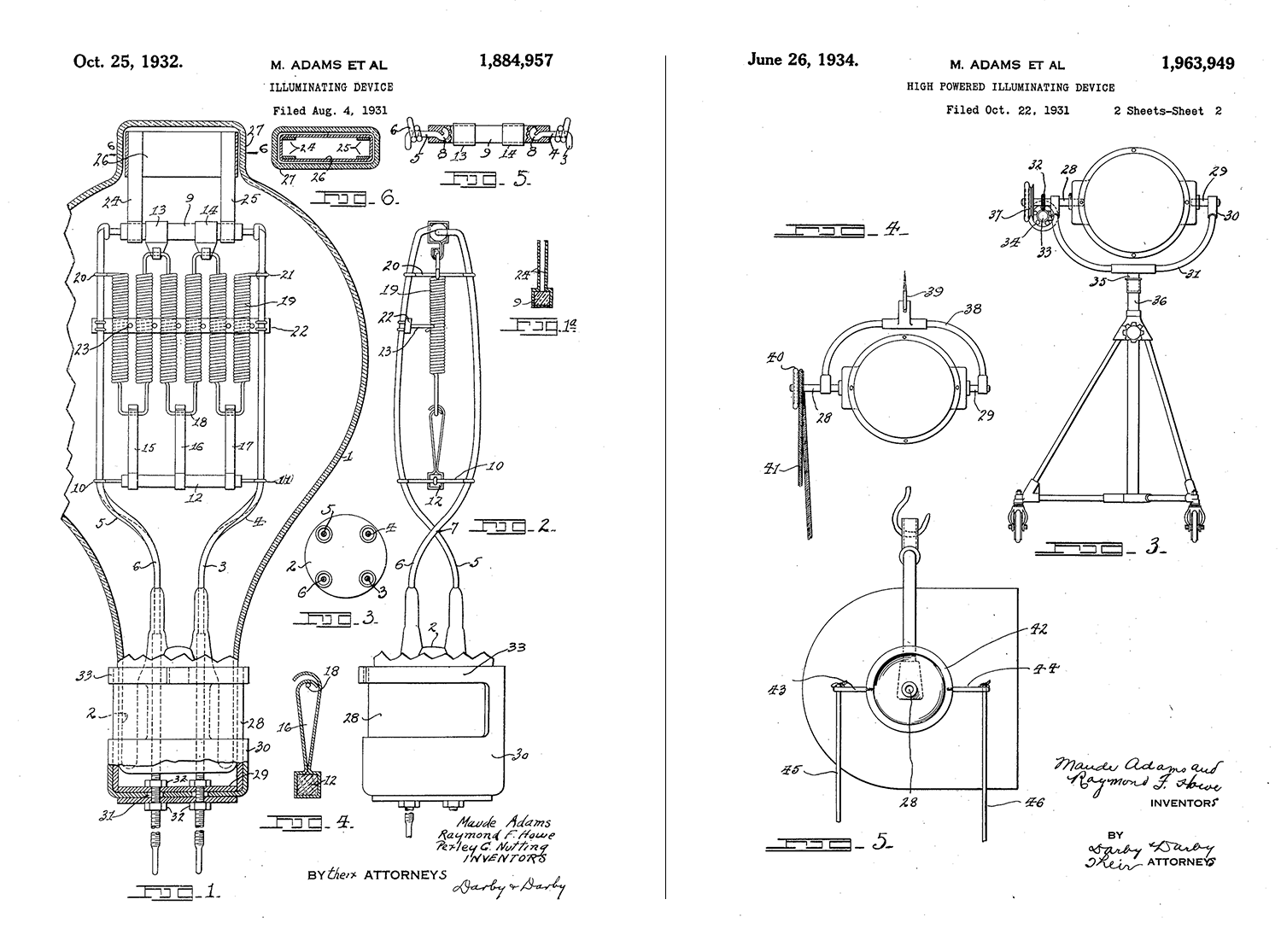
Maude Adams and her colleagues at GE received U.S. Patent Nos. 1,884,957 and 1,963,949 in 1932 and 1934, respectively. The largest incandescent bulb to date, their invention found immediate success among movie and theater producers, who benefitted from the device’s superlative maneuverability, reliability, and luminosity.
Adams performed onstage a few more times in the 1930s before settling at Stephens College in Columbia, Missouri. The president of Stephens had asked that Adams start a theater program there and gave her full control over the curriculum. It must have been a familiar arrangement to Adams: the trusting patron, a supportive community, and total autonomy.
Today, Adams’s portrait hangs on the back wall of the Stephens Playhouse. “We have her there,” explains retired theater professor Rob Doyen, “so that when you’re onstage, you know that Miss Adams is watching everything you do and supporting you.” A side room nearby, the “Maude Adams Gallery,” contains the most prized artifacts of her career, including one giant light bulb, intact, with a filament as wide as your hand.
Credits
Produced by the USPTO’s Office of the Chief Communications Officer. For feedback or questions, please contact inventorstories@uspto.gov.
Story by Adam Bisno. Contributions from Marie Ladino. Special thanks to Kim Marra and Rob Doyen. The photograph at the beginning of this story shows Maude Adams in costume as Lady Babbie in “The Little Minister“ (1897-98) and has been cropped from the original photograph in the collection of the Library of Congress.
References
Bronski, Michael A., A Queer History of the United States (Boston: Beacon, 2011), 104-28.
Clement, Elizabeth, and Beans Velocci, “Modern Sexuality in Modern Times (1880s-1930s),” in The Routledge History of Queer America, ed. Don Romesburg (New York: Routledge, 2018), 52-66.
Cott, Nancy F., “Passionlessness: An Interpretation of Victorian Sexual Ideology, 1790-1850,” Signs: Journal of Women and Culture in Society 4, no. 2 (1978): 219-36.
Edison Electric Illuminating Company of Boston, The History of Stage and Theatre Lighting (Boston: Edison, 1929), 23-33.
Faderman, Lillian, Odd Girls and Twilight Lovers: A History of Lesbian Life in 20th-Century America (New York: Columbia University Press, 1991), 1-61.
Fields, Armond, Maude Adams: Idol of American Theater, 1872-1953 (Jefferson, N.C.: McFarland, 2004), 11-13, 38-39, 55-56, 65-74, 91-92, 93, 105-7, 122-33, 147-50, 153, 155-57, 166-67, 185-98, 206-28, 239, 243-46, 256-65, 269, 301.
Flinchum, Russell, “Bassett Jones: Under Our Noses and Over Our Heads,” D-Crit, February 12, 2011.
“Incandescent Studio Lights Tested: Years of Experimenting Done by Maude Adams and General Electric Company, Metropolitan Studios Giving Practical Try-Out,” Motion Picture News 34, no. 24 (December 11, 1926): 2,249.
Jackson, Vicky, “Maude Adams,” in The Women Film Pioneers Project, ed. Jane Gaines, Radha Vatsal, and Monica Dall’Asta (New York: Columbia University Libraries, 2016), wfpp.columbia.edu/pioneer/maude-adams/.
Marra, Kim, “Adams, Maude,” in The Gay and Lesbian Theatrical Legacy: A Biographical Dictionary of Major Figures in American Stage History in the Pre-Stonewall Era,” ed. Billy J. Harbin, Kim Marra, and Robert A. Schanke (Ann Arbor: University of Michigan Press, 2005), 15-18.
Marra, Kim, Strange Duets: Impresarios and Actresses in the American Theatre, 1865-1914 (Iowa City: University of Iowa Press, 2006), 73-141.
“Maude Adams Invents Stage Lighting Device,” New York Times, January 5, 1908.
Rees, Terence, Theatre Lighting in the Age of Gas (Cambridge: Entertainment Technology Press, 2004), 81-96.
Robbins, Phyllis, Maude Adams: An Intimate Portrait (New York: Putnam, 1956), 36, 70-71, 89, 196-99, 211, 234.
Rupp, Leila J., “Romantic Friendship,” in Modern American Queer History, ed. Allida M. Black (Philadelphia: Temple University Press, 2001), 13-23.


